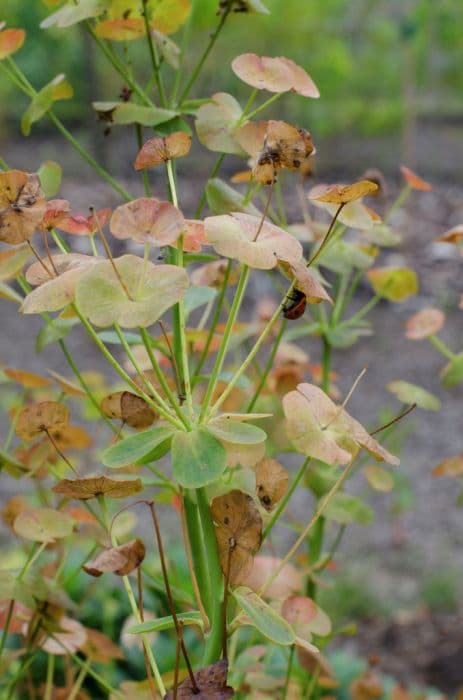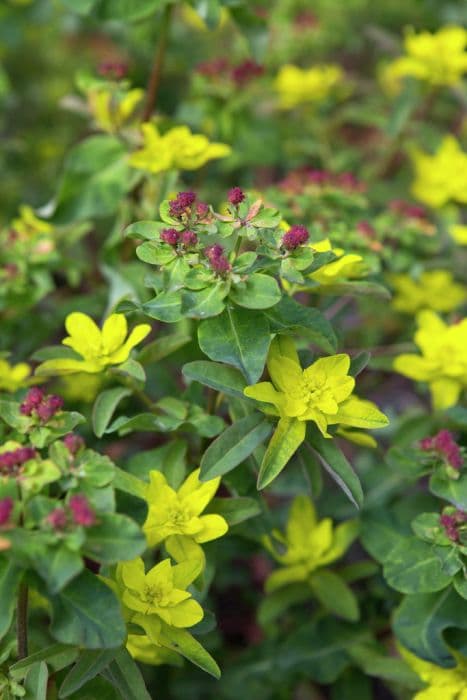Margadiles Islet spurge Euphorbia margalidiana

ABOUT
E. margalidiana is a robust, evergreen perennial or sub-shrub to 1.2m, with upright growth that may sprawl if not supported. The foliage is blue-green and the flowers yellow-green over a long period from spring to autumn
About this plant
 Names
NamesSynonyms
Margalid's Spurge, Balearic Spurge
Common names
Euphorbia margalidiana
 Characteristics
CharacteristicsLife cycle
Perennials
Foliage type
Evergreen
Color of leaves
Green
Flower color
Yellow
Height
1 foot (0.3 meters)
Spread
1 foot (0.3 meters)
Plant type
Shrub
Hardiness zones
10
Native area
Balearic Islands
Benefits
 General Benefits
General Benefits- Drought Tolerance: Euphorbia margalidiana, commonly known as Margalid's spurge, has a high tolerance for dry conditions, making it suitable for xeriscaping and water-efficient gardens.
- Low Maintenance: This species requires minimal care once established, making it ideal for gardeners looking for plants that do not demand a lot of time or resources.
- Attractive Foliage: The blue-green leaves and compact growth habit of Margalid's spurge provide aesthetic appeal and can be used to add texture and color contrast in garden designs.
- Erosion Control: The plant's root system can help stabilize soil in sloped areas, reducing erosion and benefiting landscape conservation.
- Habitat for Wildlife: Margalid's spurge can attract certain insects and pollinators, supporting local biodiversity and ecosystem health.
- Adaptability: It can thrive in a variety of soil types, provided they are well-draining, which makes it versatile for different landscape settings.
- Year-Round Interest: With its evergreen foliage, Margalid's spurge offers year-round visual interest in the garden, even in winter when other plants may die back.
- Non-Invasive: Unlike some other ornamental species, Margalid's spurge is not known to be invasive and generally stays where it is planted, reducing the risk of uncontrolled spread.
 Medical Properties
Medical PropertiesThis plant is not used for medical purposes.
 Air-purifying Qualities
Air-purifying QualitiesThis plant is not specifically known for air purifying qualities.
 Other Uses
Other Uses- Euphorbia margalidiana can be used in themed gardens, such as rock gardens or Mediterranean landscapes, due to its tolerance for dry conditions and its unique appearance.
- The plant's sap can be utilized as a natural latex source; however, caution is needed as it can be irritating to skin and eyes.
- Incorporating Euphorbia margalidiana into xeriscapes is practical for water conservation landscaping strategies.
- Its distinct form provides architectural interest in garden designs, offering a contrast to softer, leafy plants.
- Euphorbia margalidiana can be used in container gardening to add height and structure to mixed plant arrangements.
- It can serve as a living barrier or groundcover in areas where other plants struggle to thrive due to poor soil.
- The plant is sometimes included in educational collections to demonstrate the diverse forms of succulents.
- Dried specimens or parts of Euphorbia margalidiana might be used in artistic arrangements or botanical displays.
- The characteristic shape and texture of Euphorbia margalidiana can inspire designs in various fields, including fashion and architecture.
- Photographers might find Euphorbia margalidiana a compelling subject for its unique silhouette and structural complexity.
Interesting Facts
 Feng Shui
Feng ShuiThe Euphorbia is not used in Feng Shui practice.
 Zodiac Sign Compitability
Zodiac Sign CompitabilityThe Euphorbia is not used in astrology practice.
 Plant Symbolism
Plant Symbolism- Resilience: Euphorbia margalidiana, commonly known as Margalid's Spurge, often symbolizes resilience due to its ability to thrive in arid and rocky environments, showing tenacity in the face of harsh conditions.
- Adaptability: This plant can adapt to a variety of soil types and environmental conditions, symbolizing the capacity to adjust to different situations in life.
- Protection: With its toxic sap, Margalid's Spurge represents the concept of protection, serving as a natural deterrent against herbivores and thus symbolically against negative forces in life.
- Healing: Historically, various Euphorbia species have been used in traditional medicine. This gives Margalid's Spurge a symbolic meaning of healing, despite the fact that the sap can be irritating to the skin and toxic if ingested.
- Uniqueness: Euphorbia margalidiana's distinctive appearance, with its compact form and greenish-yellow flowers, symbolizes uniqueness and standing out from the crowd.
 Water
WaterThe Balearic Spurge, commonly known as Euphorbia margalidiana, should be watered infrequently as it is drought-tolerant. Allow the soil to dry out completely between watering sessions. Typically, watering once every two weeks with about 16 ounces of water is adequate. During the winter months, reduce the frequency further to once a month or less depending on ambient moisture. The key is to avoid water-logging, which can cause root rot.
 Light
LightBalearic Spurge thrives in bright light conditions but can also tolerate partial shade. The ideal spot for this plant is a location where it receives several hours of direct sunlight each day, such as a south-facing window. Avoid placing it in deep shade as this will hinder growth and vitality.
 Temperature
TemperatureBalearic Spurge prefers a warm climate with temperatures ranging between 50°F to 77°F. It can withstand a minimum temperature of around 40°F but should be protected from frost. The optimal temperature range for this plant is between 60°F and 70°F, which promotes healthy growth.
 Pruning
PruningBalearic Spurge may benefit from light pruning to remove any dead or damaged stems and to maintain its shape. This should be done in the late winter or early spring before new growth begins. Wear gloves when pruning Euphorbia margalidiana, as its sap can be irritating to the skin. Pruning once a year is generally sufficient.
 Cleaning
CleaningAs needed
 Soil
SoilFor Euphorbia margalidiana, commonly known as Balearic Island milkwort, the best soil mix is well-draining with a blend of loam, sand, and a small amount of peat. The preferred soil pH for Balearic Island milkwort ranges from slightly acidic to neutral, around 6.0 to 7.5.
 Repotting
RepottingBalearic Island milkwort should generally be repotted every two to three years or when it has outgrown its pot. Gently refreshing the soil during repotting helps maintain nutrient levels and soil structure.
 Humidity & Misting
Humidity & MistingBalearic Island milkwort thrives in moderate humidity levels and does not require a highly humid environment. Aim for humidity levels similar to average room conditions, which tend to be around 40-60%.
 Suitable locations
Suitable locationsIndoor
Place in bright, indirect light and ensure good airflow.
Outdoor
Position in full sun to partial shade, protect from harsh winds.
Hardiness zone
9-11 USDA
 Life cycle
Life cycleEuphorbia margalidiana, commonly known as Margalid's spurge, begins its life cycle as a seed, which germinates in well-drained soil, typically in spring when the temperature and moisture conditions are favorable. After germination, the seedling stage follows, where the plant develops its first true leaves and an initial root system. As it enters the juvenile stage, Margalid's spurge develops a more robust root system and begins to form the characteristic structure of woody stems with succulent leaves. This species flowers in the warmer months, producing small, inconspicuous flowers that are typical of the Euphorbiaceae family, which rely on wind or insect pollination for reproduction. After successful pollination, the flowers develop into fruit that contains seeds, which, when mature, are dispersed by various means such as wind or animal movement. The plant can also propagate vegetatively through cuttings, but this method is less common in its natural setting.
 Propogation
PropogationPropogation time
Spring-Early Summer
Propogation: Euphorbia margalidiana, popularly known as Margalid's Spurge, is most frequently propagated through seed sowing. The best time to sow seeds is in spring when temperatures are consistently around 70 degrees Fahrenheit (21 degrees Celsius). For this method, collect seeds from the parent plant after the pods have dried and split open. Carefully plant these seeds in a well-draining soil mixture, lightly cover them with soil, and maintain moisture without making the soil waterlogged. Place the pot in a warm, bright location but out of direct sunlight to encourage germination, which usually occurs within a few weeks. It's vital to handle Euphorbia seeds and seedlings with care due to the plant's potentially irritating sap.


![Spurge [Silver Swan]](/_next/image?url=https%3A%2F%2Fplants-admin.emdemapps.com%2Fimages%2Fplants%2F%2Fimages%2F604b573f6c8f6.png&w=640&q=75)






